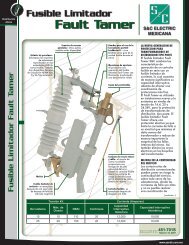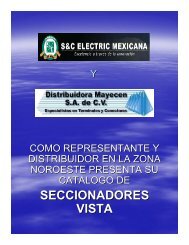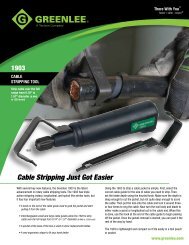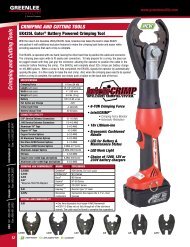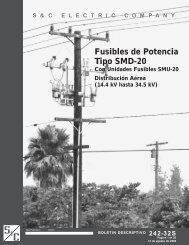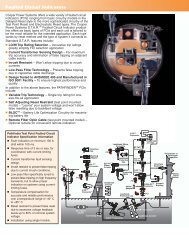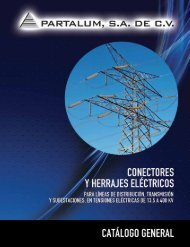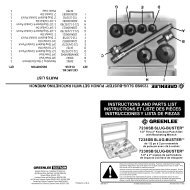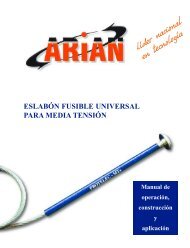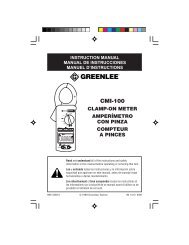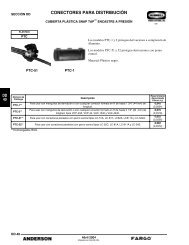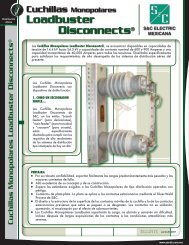OVERHEAD LINE SPLICES
OVERHEAD LINE SPLICES
OVERHEAD LINE SPLICES
- No tags were found...
You also want an ePaper? Increase the reach of your titles
YUMPU automatically turns print PDFs into web optimized ePapers that Google loves.
SECTION DJREFERENCE DATADJ2C. For welded connectors with a copper lined contact:1. Firmly bolt the copper lined contact section of connectorto the mating contact surface or to a suitable heatsink prior to welding. This prevents damage to thebonded liner.2. Weld the aluminum connection in accordance withsteps A or B above. If a heat sink is used, allow connectorto cool before removing. The connector may becooled by quenching in water.PROCEDURE #3—COMPRESSION CONNECTIONS1. Vigorously clean the conductor contact area with astainless steel brush. Do not attempt to clean connectorbarrel. It is not necessary to apply sealant to the conductor.All connectors will have sealant applied at thefactory.2. Fully insert the conductor into the barrel and crimp.Crimping should begin nearest the center of sleevetype connectors. For closed barrel type connectorscrimping should begin at the end and work toward theopen end. Excess sealant squeezed out of the joint maybe smoothed out around the mouth of the barrel. Allexcess sealant must be removed from EHV Connectorsor any cable insulation.Installation Recommendations for Aluminum toCopper Connections Using Aluminum ConnectorsConnectors with contact sealant—Aluminum connectorscan be used for making aluminum to copper connectionsif the proper installation care is observed. This includes the useof a sealant in accordance with practices outlined above. Useof a sealant protects the connection from oxide formation andelectrolytic corrosion for as long as it remains present in theconnection completely coating the surfaces and sealing outmoisture.Added protection in addition to sealants is available. Aluminumdistribution connectors can be supplied with plating orwith copper lined contacts.Bi-Metallic Transition Plates-Aluminum to copper connectionsbetween flat NEMA drilled tongues and bars can bemade using transition plates (Type TP). These plates areformed from sheets of 80% aluminum 20% copper which aremolecularly bonded together. Best results are obtained by usingcontact sealant. Always position the aluminum conductorabove the copper conductor.Tin Plating—Tin plating can be furnished on certain connectorsby adding suffix “-GP” to the catalog number, aluminumdistribution.Hardware—Anodized Aluminum Clamping Bolts are standardwith most Aluminum Power Connectors and may be suppliedat extra cost with other connectors. The bolts arefabricated 2024-T4 aluminum and are anodized. After anodizing,the coating is sealed with a dichromate solution which impartsa yellow-green finish.Standard nuts furnished on aluminum bolts are 6061 T6 drywaxed coated.Insulator attachment hardware for bus supports is galvanizedsteel.BRONZE AND COPPER CONNECTORSCopper Casting AlloysOur modern, all electric furnaces provide copper alloy castingsof the highest quality possible. The alloy used will vary accordingto the requirement of the component.Connectors requiring high tensile strength and corrosion resistancein application are cast from Anderson Alloy 112 (ASTMB-30 Alloy No. C95500). The 112 alloy is a 10% aluminum,4.5% nickel copper alloy with a minimum tensile strength of90,000 PSI.Connectors requiring current-carrying abilities and reasonablestrength are cast from Anderson Alloy 123 (ASTM B-30 AlloyNo. C84400). The 123 metal is a 81% copper—3% tin—7%lead—9% zinc alloy.For heavy duty copper compression connectors CDA 110 copperis used. This 110 alloy is 99.9% pure copper.Other copper compression connectors are made from commerciallypure high conductivity wrought copper.Conductivity is purposely omitted in the above descriptionsbecause it is often confused with current-carrying capacity.While connector alloys may vary in conductivity, design parametersare applied in each case to assure adequate capacity.While connector alloys may vary in conductivity, design parametersare applied in each case to assure adequate capacityto meet the particular application.Installation Recommendations for Bronze andCopper ConnectorsBronze Bolted Connectors—Contact sealants are not normallyrequired in copper connections. However, the use ofsealant is recommended in severe corrosive environments anddirect burial applications such as ground grids.Vigorously clean the conductor and connector contact surfaceswith a stainless steel wire brush.Alternately and evenly tighten bolts with a torque wrench tothe values shown in Recommended Torque Values table.Hardware—Silicon bronze hardware is normally suppliedfor all conductor clamping bronze components. Stainless steelhardware may be substitued where and when necessary.DJ-2August 2010HUBBELL ® Power Systems




